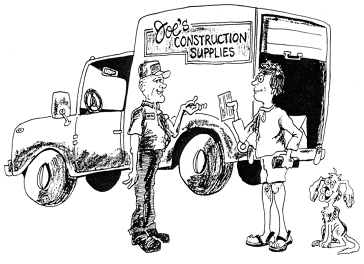
The commerce of the world is conducted by the strong;
and usually it operates against the weak.
- Henry Ward Beecher
As an Owner solicits and coordinates bid proposals from Trade Contractors and Suppliers, there'll be a need to organize a system for tracking expenditures. A Purchase Order system tracks the costs of your project. The complexity of your Purchase Order system will depend on the complexity of your Drawings and Specifications because a good system requires that ALL materials and labor have a written Purchase Order. So, the more sophisticated your project, there will likely be a more sophisticated means to track costs.
Standard forms are available; however, it may be more appropriate to first understand the meaning and usefulness of a Purchase Order system before buying standard forms which may be ill-suited for your project. You may decide NOT to purchase a pre-made form, and simply create your own format for authorizing a purchase.
In other words, create the Purchase Order system around the specific requirements of your project and what suits your personal style. Just as your Drawings and Specifications reflect the unique circumstances surrounding your home style, your Purchase Order system will match these same unique qualities.
The rudimentary form of a Purchase Order system first takes shape as the Owner follows a process of progressive approximation. The Owner should allow for flexibility in how the tracking system is fully developed. What you're trying to get into writing is the terms of purchase and delivery to your site of all labor and material required to complete the project.
To be competitive, it's important that the Owner obtain bid proposals from as many Trade Contractors and Suppliers as possible. The information in the bid proposals extrapolates from Drawings and Specifications, into Agreements regarding the Conditions under which the work will be performed, and then these terms extend into your Purchase Order system. The Purchase Order system turns bid proposals into terms of purchase and delivery based on the Conditions of Agreement.
AFTER you receive bid proposals from different Trade Contractors and Suppliers, and BEFORE you sign Agreement and Condition statements with each firm, you'll certainly be thinking about ways to track expenditures to guarantee that what you pay is consistent with the price and terms agreed on for the materials and labor to be purchased. This is the purpose of the Purchase Order system.
Awarding the contract will normally be placed with the bidder whose price, quality, service, delivery, product installation cost, and manufacturer warranty, taken as a whole, will offer the Owner the best possible deal for the work to be accomplished. Purchase Orders will be based on Drawings and Specifications and reiterate terms stated in the Agreement and Conditions documents. Purchase Orders are issued based on the owner's requirements to provide the seller with the required information.
A PURCHASE ORDER SHOULD INCLUDE:
* Your name, address, and phone number
* Site address and phone number
* Supplier/Contractor's name, address, and phone number
* Project name
* Date of issue
* Type of delivery
* Date of delivery or "Will Call" for delivery
* Payment terms and Lien Waiver
* Quantity
* Description of Goods or Services
* Unit Price
* Total Amount
* Space for purchase and receipt authorizations

The simplest type of Purchase Order is a simple statement that reiterates the Conditions of Agreement based on Drawings and Specifications. Duplicate copies are made of the Purchase Order: one for the buyer and another for the seller. The Purchase Order is sent to the seller immediately after Agreement is made. When the materials are delivered or the work is completed, the Owner reviews the Purchase Order to ensure there are no inconsistencies. When the seller presents an Invoice for payment to the Owner, the Owner re-checks the Invoice to ensure that it matches the Purchase Order.
A PURCHASE ORDER TERM'S SHOULD INCLUDE:
* Warranties and Guarantees of Product Manufacturer
* Product Installation Instructions & Warranties and Guarantees of Workmanship
* Special Order or Delivery instructions if long lead time is required
* The right to cancel the Purchase Order if seller alters the Conditions of Agreement
* Seller will fix damages which occurs during delivery to site
Quite often, you'll place an order for materials or labor over the phone or make a deal over a handshake. This type of informal transaction may get the job done, but what do you do if or when there's a problem?
No doubt, variances may occur. For cost increases, the questions of "how" and "why" must be answered prior to the Owner's payment. Change orders need to be made in writing by mutual agreement! In some instances, the Owner will be responsible for additional costs; but more often, the differences will be generated by the seller and in the seller's favor. The concern should be for accountability: the seller must explain the change AND the buyer must be willing to pay for the change.
Remember: A Purchase Order system is simple to implement but requires discipline. The Owner is required to solicit bid proposals based on Drawings and Specifications, negotiate Conditions under which work will be performed, sign Agreements, and issue Purchase Orders before the work begins. Any new changes must be in writing.
Most Trade Contractors and Suppliers are accustom to providing this level of detail to Owners and getting all information ahead of time for residential construction. The advantage for the Owner is worth the effort because the major benefit is to track costs throughout the building process. Other benefits include catching sellers' billing mistakes, controlling the delivery schedule, and avoiding disputes as a result of poor communication.
To gain further financial accountability of your project, the Owner will want to maintain a Check Register/Job Cost Journal. One way to approach this concern is to utilize a product provided by New England Business Services, a company that sells standard forms to small business owners. "NEBS" incorporates a Personal One-Write Check System into a single payment log. As each check is written an imprint is made directly in the Register, and then the cost can be extended across the page into the log. This eliminates transcription errors, helps classify expenses, and provides an easy audit trail showing at a glance what you've spent on your project.
Assuming a separate checking account is opened for construction purposes, the NEBS system allows the Owner to include a personalized heading, bank name and address, and the bank's magnetic encoding that usually appears on the bottom of a standard, bank-issued check. Bookkeeping is made easier by maintaining construction-related expenses separate from a personal account. For recordkeeping purposes, there's one source in your files if there's ever a need in the future to refer back to construction expenses.
Standard practice in the construction industry for billing is to submit an Invoice for payment on the 30th of the month in which the work was performed, and payment is expected by the 10th of the following month. Unless other terms are specified, the Owner can expect to follow this billing practice. If early payment is requested, ask for a special discount; it's not unusual to receive a 1% to 10% discount for immediate payment by check. Cash "deals" should be avoided and always insist on getting a lien waiver at each payment with check!
One more time: A Purchase system encourages the Owner to create an Order for all materials and labor included in the Drawings and Specifications. Suppliers and Contractors offer to provide materials and labor under specific Conditions, and a Purchase Order will be issued based on your Agreement with them. After the materials/products are provided to the Owner's satisfaction, payment is made from the Check Register, and the expense entered into a Job Cost Journal.
Don't forget: You need to organize a system for tracking expenditures based on Drawings and Specifications according to the Conditions of Agreement!
| 



